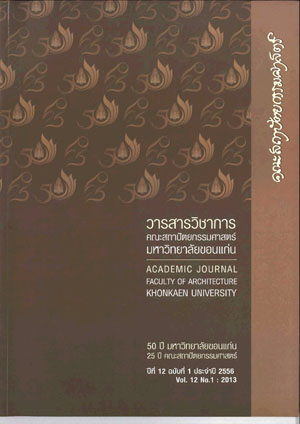ผลของมวลสารภายในต่อการถ่ายเทความร้อนผ่านหลังคา
คำสำคัญ:
มวลสารภายใน, ค่าความร้อนจำเพาะ, การถ่ายเทความร้อน, Internal Mass, Specific Heat, Heat Transmissionบทคัดย่อ
งานวิจัยนี้มีจุดมุ่งหมายในการศึกษาคุณสมบัติของวัสดุมวลสารภายในที่มีผลต่อการถ่ายเทความร้อนผ่านหลังคา โดยแบ่งการศึกษาออกเป็น 2 ขั้นตอน ขั้นตอนแรกทำการศึกษาเปรียบเทียบผลของมวลสารภายในที่มีนํ้าหนักแตกต่างกันต่อพฤติกรรมการถ่ายเทความร้อนผ่านหลังคา การทดลองนี้ประกอบด้วยกล่องทดสอบที่ไม่มีมวลสารภายใน กล่องทดสอบที่มีมวลสารภายในเป็นอิฐมอญนํ้าหนัก 25, 50 และ 75 กิโลกรัม ขั้นตอนที่สองทำการศึกษาเปรียบเทียบผลของมวลสารภายในที่มีค่าความร้อนจำเพาะและความหนาแน่นแตกต่างกันต่อพฤติกรรมการถ่ายเทความร้อนผ่านหลังคา การทดลองนี้ประกอบด้วยกล่องทดสอบที่มีมวลสารภายในเป็นอิฐมอญ คอนกรีตบล็อก แผ่นยิบซั่มและแผ่นไม้อัดซีเมนต์ โดยแบ่งการทดลองออกเป็น 3 ชุด คือ มวลสารภายในกล่องทดสอบมีนํ้าหนัก 25, 50 และ 75 กิโลกรัม ผลการศึกษาพบว่าความสามารถในการลดความร้อนของมวลสารภายในกล่องทดสอบขึ้นอยู่กับคุณสมบัติด้านนํ้าหนัก ความหนาแน่น และค่าความร้อนจำเพาะตามลำดับ ส่วนความสามารถในการหน่วงเหนี่ยวความร้อนของมวลสารภายในกล่องทดสอบจะขึ้นอยู่กับคุณสมบัติด้านนํ้าหนัก การเลือกวัสดุมวลสารภายในเพื่อลดความร้อนและหน่วงเหนี่ยวความร้อนในช่วงเวลากลางวันควรเลือกวัสดุที่มีนํ้าหนัก ความหนาแน่น และค่าความร้อนจำเพาะมากตามลำดับ การใช้มวลสารภายในอาคารจะเหมาะสมกับอาคารที่ใช้งานเฉพาะในช่วงเวลากลางวันทั้งอาคารที่ใช้ระบบปรับอากาศและไม่ใช้ระบบปรับอากาศ หากใช้งานในช่วงเวลากลางคืนอาคารที่ใช้ระบบปรับอากาศจะสิ้นเปลืองพลังงานในการรีดความร้อนออกจากมวลสารภายใน ส่วนอาคารที่ไม่ใช้ระบบปรับอากาศอาจใช้การระบายอากาศโดยวิธีธรรมชาติเพื่อช่วยลดความร้อนภายในอาคาร
The Effect of Internal Mass on Heat Transmission through Roof
Pornsawat Piriyasatta
The purpose of this research is to study the internal mass properties of materials which influence the heat transmission through roof. The study has two parts. The first part is to compare the effect of internal mass which has different weights on the heat transmission through roof. The experiment consists of the test cells which have internal mass and no internal mass. The internal mass in test cells contains bricks of 25, 50, and 75 kilograms. The second part is to compare the effect of the internal mass which has different specific heat and density on the heat transmission through roof. This experiment comprises the test cells which have the internal mass. The internal mass in test cells includes bricks, cement blocks, gypsum boards, and wood cement boards. This experiment has 3 sets of mass weights of 25, 50, and 75 kilograms. The result is that the effectiveness of reducing heat transmission of internal mass in test cells depends on the properties of weight, density and specific heat respectively. The effectiveness of time lag of the internal mass depends on the properties of weight. The selection of internal mass materials for reducing heat and time lag in daytime should be in the order of high weight, density, and specific heat. The use of internal mass is appropriate for buildings that are used in daytime for both air-conditioned and non-air-conditioned buildings. If the buildings are used in nighttime, The air-conditioned buildings will consume high energy in reducing heat from the internal mass. The non-air-conditioned buildings can use natural ventilation in order to reduce heat in the buildings.
ดาวน์โหลด
รูปแบบการอ้างอิง
ฉบับ
ประเภทบทความ
สัญญาอนุญาต
ทัศนะและข้อคิดเห็นของบทความที่ปรากฏในวารสารฉบับนี้เป็นของผู้เขียนแต่ละท่าน ไม่ถือว่าเป็นทัศนะและความรับผิดชอบของกองบรรณาธิการ




